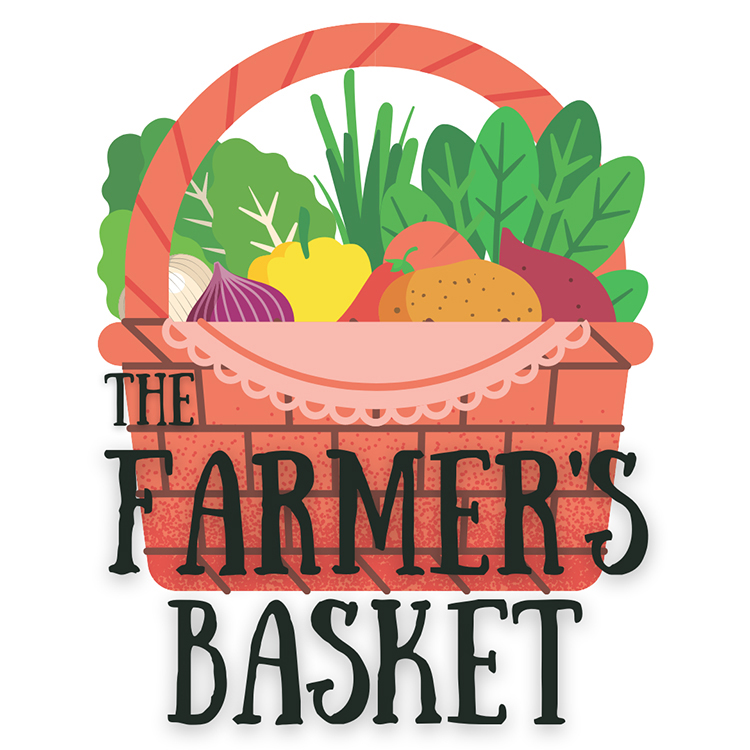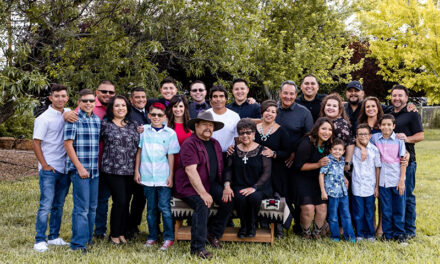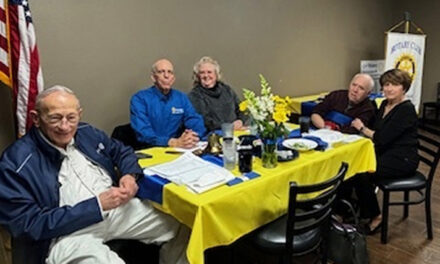
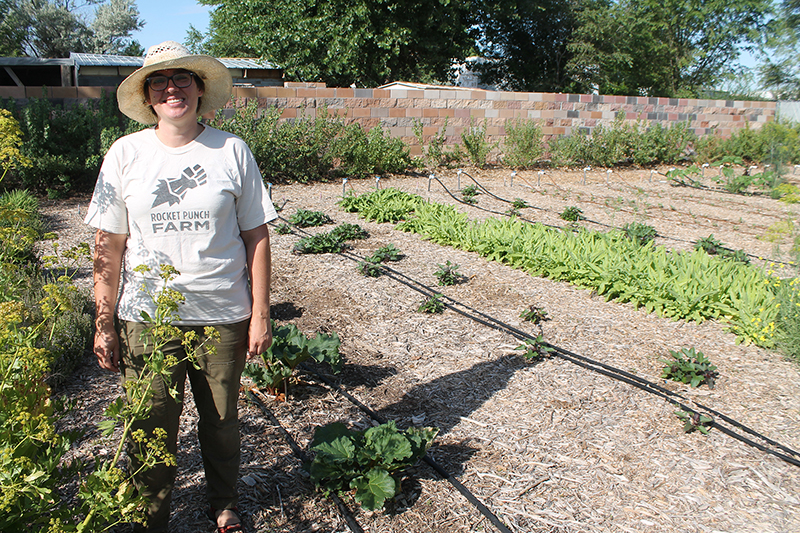
Julia M. Dendinger | News-Bulletin photo
Amelia Vogel, co-owner of Rocket Punch Farm in Belen, stands in her diverse garden. She and her husband, Jason Schilberg, have planted a variety of plants for both humans and wildlife.
It’s underfoot everyday of our lives, but it’s mostly ignored.
The soil in our environment presents in a myriad of ways — from soft, dry and sandy to hard, almost impenetrable clay, and everything in between.
If you’re someone with a green thumb or an aspiring green thumb, the start to successful growing starts with healthy soil.
At Rocket Punch Farm in Belen, Amelia Vogel and her husband, Jason Schilberg, have created a small farm dedicated to healthy soil, people and planet.
“Healthy soil needs to be focused on biology. The prevailing paradigms is about chemistry,” Vogel said. “You get a soil test and they check your pH and your salinity and are looking for different soil nutrients. That’s the traditional soil test.
“There are emerging soil tests that are more about biology. Looking at the microbe counts, the bacteria, the fungi. The other little things that you can only see under a microscope. Soil life includes insects and earthworms and even man, because basically soil is an ecosystem unto itself. Healthy soil is about having a thriving and diverse community of living things in the soil.”
To create and encourage that thriving and diverse community, Vogel and Schilberg have used simple mulching techniques and compost on their property.
They try to follow as many of the five healthy soil principles identified by the New Mexico Healthy Soil Working Group as they can, she said.
“There’s keeping the soil covered, which is the mulch. Encouraging biodiversity, which is why we have lots of diverse plantings,” Vogel said. “That includes animals, which can be livestock, but on our farm, it’s insects. Earthworms and pollinators, they count. That’s why we intentionally plant flowers and have a lot of plantings to encourage wildlife.”
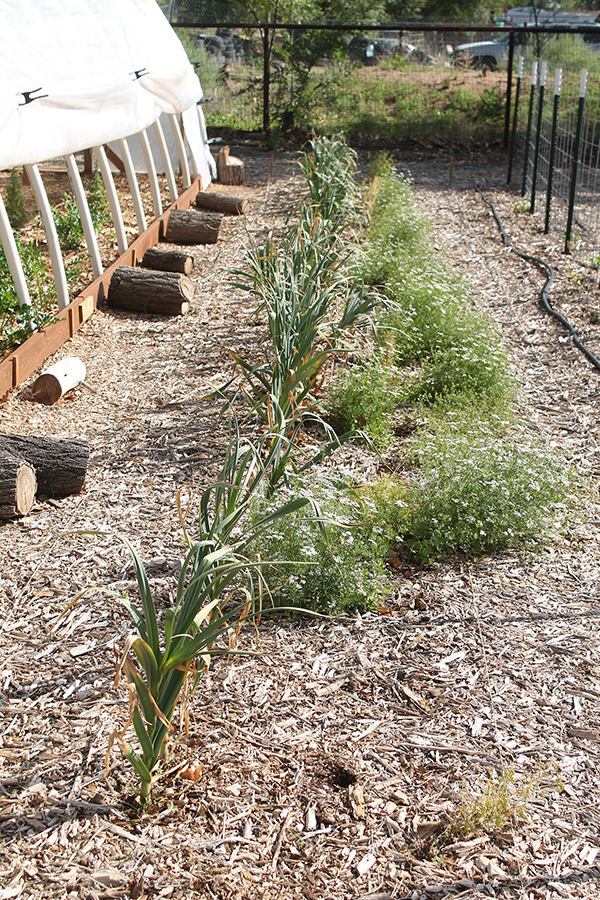
Julia M. Dendinger | News-Bulletin photo
At Rocket Punch Farm in Belen, they take an approach of “try it and see,” planting various varieties of garlic, onions, tomatoes and more. Amelia Vogel, co-owner, said there are successes and failures, but there’s always next season to try something else.
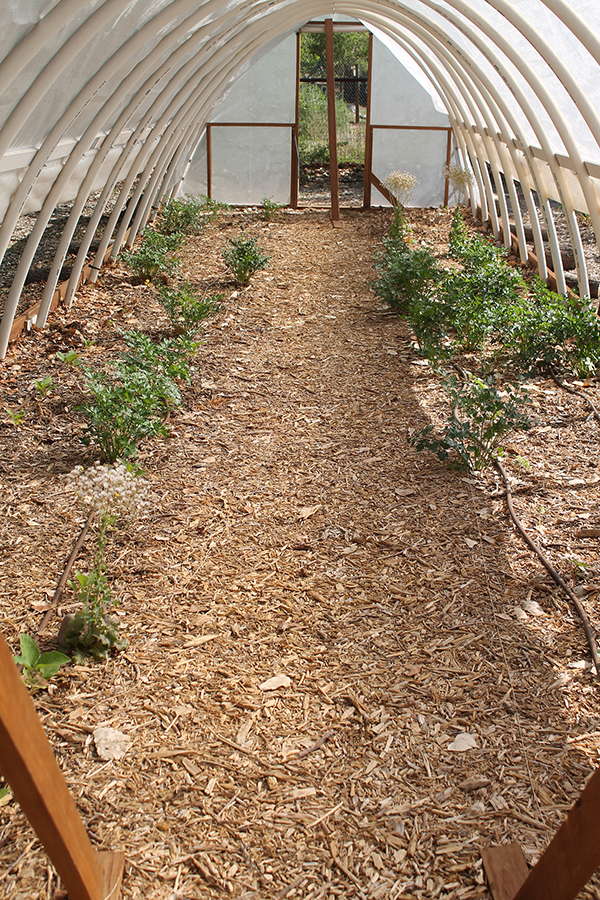
Julia M. Dendinger | News-Bulletin photo
Even the greenhouse at Rocket Punch Farm receives a woodchip mulch treatment, which helps retain moisture for the plants.
Most of the couple’s growing area is mulched with wood chips, and was done using the sheet-mulching method. Vogel said the technique can be as simple or as complicated as a person wants.
In their case, they found large cardboard boxes, removed any tape or staples, opened them up so they had a large sheet of cardboard and then laid it over areas where they had mowed.
“We mowed the weeds, put the cardboard down and then put about 4 inches of wood chips on top,” she said. “Some people like to do compost then the wood chips, but that’s up to you.”
The cardboard breaks down and smothers the weeds underneath while the wood chips compact down and “knit” together, creating a cover that is less likely to blow away in the New Mexico wind, Vogel said.
“Mulch is a second best way to keep soil covered. Better still is to have living roots, which is one of those the healthy soil principles,” she said.
Another of the healthy soil principles is to minimize tillage, which Vogel and Schilberg did by using the sheet mulch method. After several months, they simply pushed aside the wood chips on top, cut an ‘X’ in the cardboard, dug a small hole and planted their seedlings.
“The mulch does a lot of the work,” she said.
The sheet mulch method can be used with any organic matter someone has access to such as old leaves, grass clippings from untreated lawns, manure or pine needles.
That same organic matter can also be used to make compost. A traditional compost pile is something anyone can start if they have a some room. Vogel advises putting it in a shady spot if possible and to keep it moist.
“We keep ours covered to reduce moisture loss. You don’t want it to turn to soup, but you don’t want to be bone dry either,” she said. “(How quickly it dries out) is going to depend on the weather and how large your compost pile is. A smaller compost pile is going to dry out faster because of surface area to mass ratio.”
Compost can be a rather slow project, Vogel said, but things will break down.
“Entropy is real. Things are going to break down, but if it’s not breaking down, you probably just need to water it,” she said. “There’s really no wrong way to do it.”
Other organic matter that can be added to a compost pile include household vegetable and fruit scraps, egg shells and coffee grounds.
Vogel said if you “turn” your compost pile — mixing the organic matter and bringing what’s on the bottom to the top — it will break down faster and create a “hotter” compost, but there are trade offs.
“There’s oxidation that’s happening and that process, it’s creating heat and it also off gases, so you’re probably losing more carbon into the atmosphere,” she said. “At different temperatures of composting, you get different microbes that are active, bacteria versus fungi, different organisms, living in the soil, in the compost.”
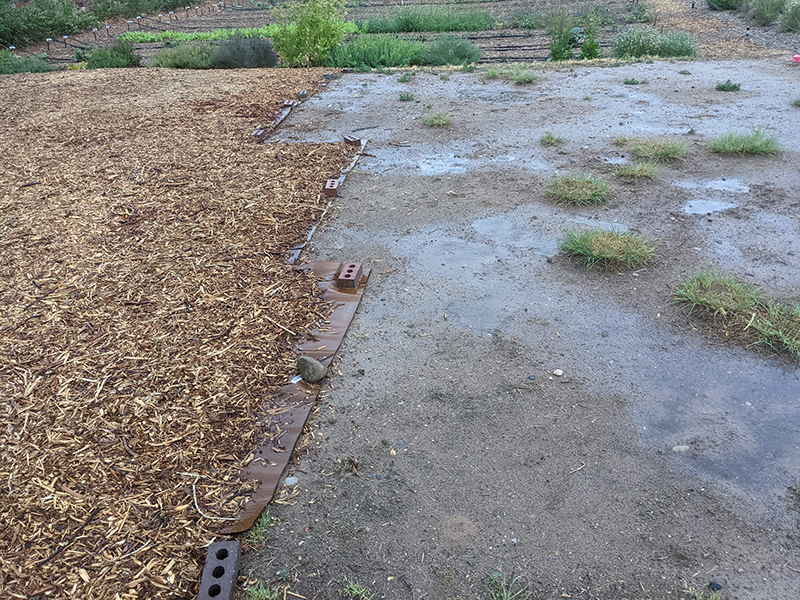
Photo courtesy of Amelia Vogel
At Rocket Punch Farm in Belen, the effects of sheet mulching, left, can be seen during the recent monsoon rains. The unmulched area is puddling and a muddy mess because the bare soil can’t absorb the rain as fast as it’s falling. The mulched area is soaking it all up.
If a compost pile isn’t your style, there are bioreactor composters, which have a pipe and cloth system that allows for aerobic composting.
Vogel uses a Johnson-Su bioreactor she bought from the Valencia Soil and Water Conservation District. Anyone interested in a bioreactor kit can contact the district at 505-864-8914.
The compost from a bioreactor is more microbially active, she said
Compost, in general, is more of a soil conditioner, adding nutrients, helping to adsorb water.
“It helps to break up or make soil to be that desirable what they call cake-like, soil, where it’s crumbly and loose. Chocolate cake they call it,” she said. “But it isn’t sandy at the same time. That happy medium.
“(Compost) is a soil conditioner or soil additive with the intention of putting life back in the soil. When you put life back into the soil, that life can unlock the nutrients that are already there and make them available for your plants.”
Vogel advises anyone who wants to begin making their soil healthier to start small and build up, giving the reminder that people aren’t going to be able to “check all the boxes.”
“You have the five principles and I can’t do all that. You know, I still use paper napkins. I am not the perfect eco queen,” she says with a laugh. “Maybe make some small changes where you can, with what works best for you. When you feel confident, find another one.”
She encourages people to compost and garden with their neighbors to encourage one another and share knowledge.
Advertisement
Julia M. Dendinger began working at the VCNB in 2006. She covers Valencia County government, Belen Consolidated Schools and the village of Bosque Farms. She is a member of the Society of Professional Journalists Rio Grande chapter’s board of directors.
